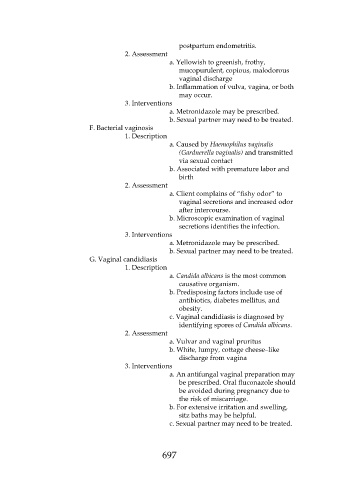Page 697 - Saunders Comprehensive Review For NCLEX-RN
P. 697
postpartum endometritis.
2. Assessment
a. Yellowish to greenish, frothy,
mucopurulent, copious, malodorous
vaginal discharge
b. Inflammation of vulva, vagina, or both
may occur.
3. Interventions
a. Metronidazole may be prescribed.
b. Sexual partner may need to be treated.
F. Bacterial vaginosis
1. Description
a. Caused by Haemophilus vaginalis
(Gardnerella vaginalis) and transmitted
via sexual contact
b. Associated with premature labor and
birth
2. Assessment
a. Client complains of “fishy odor” to
vaginal secretions and increased odor
after intercourse.
b. Microscopic examination of vaginal
secretions identifies the infection.
3. Interventions
a. Metronidazole may be prescribed.
b. Sexual partner may need to be treated.
G. Vaginal candidiasis
1. Description
a. Candida albicans is the most common
causative organism.
b. Predisposing factors include use of
antibiotics, diabetes mellitus, and
obesity.
c. Vaginal candidiasis is diagnosed by
identifying spores of Candida albicans.
2. Assessment
a. Vulvar and vaginal pruritus
b. White, lumpy, cottage cheese–like
discharge from vagina
3. Interventions
a. An antifungal vaginal preparation may
be prescribed. Oral fluconazole should
be avoided during pregnancy due to
the risk of miscarriage.
b. For extensive irritation and swelling,
sitz baths may be helpful.
c. Sexual partner may need to be treated.
697

